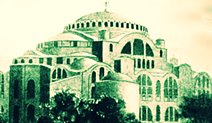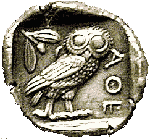| ● The Purpose |
|
The “Byzantine Chronicle” web site (byzantium.gr), is a short guide and a quick reference to various aspects of the Byzantine history. The site initially was focused on the Byzantine emperors only. Recently, several other topics have been added such as the battles of Byzantium and the Byzantine Dignitaries and Offices (in Greek only). |
| ● Byzantium |
|
The terms "Byzantine Empire" and "Byzantium" are conventionally used to describe the Greek-speaking Eastern Roman Empire during the Middle Ages, centered at its capital in Constantinople. These terms derive from the original Greek name for Constantinople; Byzantion. The name is ancient, but the Byzantines themselves never used the terms "Byzantine" and "Byzantium", at least not with the meaning that they have today.
|
| ● The Byzantine Epoch |
The end of the Byzantine empire came on the 29th May 1453. This is quite clear. There is no consensus, however, on the starting date of the Byzantine period. The fact is that the process of Hellenization and Christianization, which transformed the Roman Empire into the Byzantine one, started gradually in the days of Diocletian, was dramatically advanced by the decisions of Constantine the Great, was accelerated after Theodosius I and was concluded during the reign of Heraklios In this site, we follow the most common assumption: Byzantium begins in 330 A.D., the year that Constantinople became the new capital of the Roman Empire. So, the chronology of the site covers the period 330 to 1453: A total of 1123 years. |
| ● Historical periods |
The history of Byzantium is typically separated in 3 periods: - Early Byzantium (330-610) - Middle Byzantium (610-1204) - Late Byzantium (1204-1453) Sometimes the 57 years of the Nicean empire (1204-1268) are considered as a separate period or sub-period. In this site, the division in historical periods is based on the most common division in early-middle-late and, in addition, for easier navigation, the middle period is broken in two parts.
|
| ● The content |
|
The purpose of the Byzantine Chronicle is to give a quick look to all the Byzantine emperors. The concept of the presentation is to show one dedicated web page with full data for each emperor. Except from the main view, there are other views of the same information in different presentations, like the Classification of Emperors, the Plain-list, the Maps page.
|
| ● The Emperors’ serial number |
|
The serial numbers shown in the upper right corner on the record sheet for each emperor do not follow any official standard numbering system for the Byzantine rulers. You will not find them in any other source. Their purpose is to facilitate navigation in this site only. |
| ● Who are "we" |
My name is Manolis Papathanassiou. I am an engineer and a Web designer. Another relevant project of mine: Kastrologos about all the medieval castles of Greece. And a less relevant project: The Presidents of USA |






